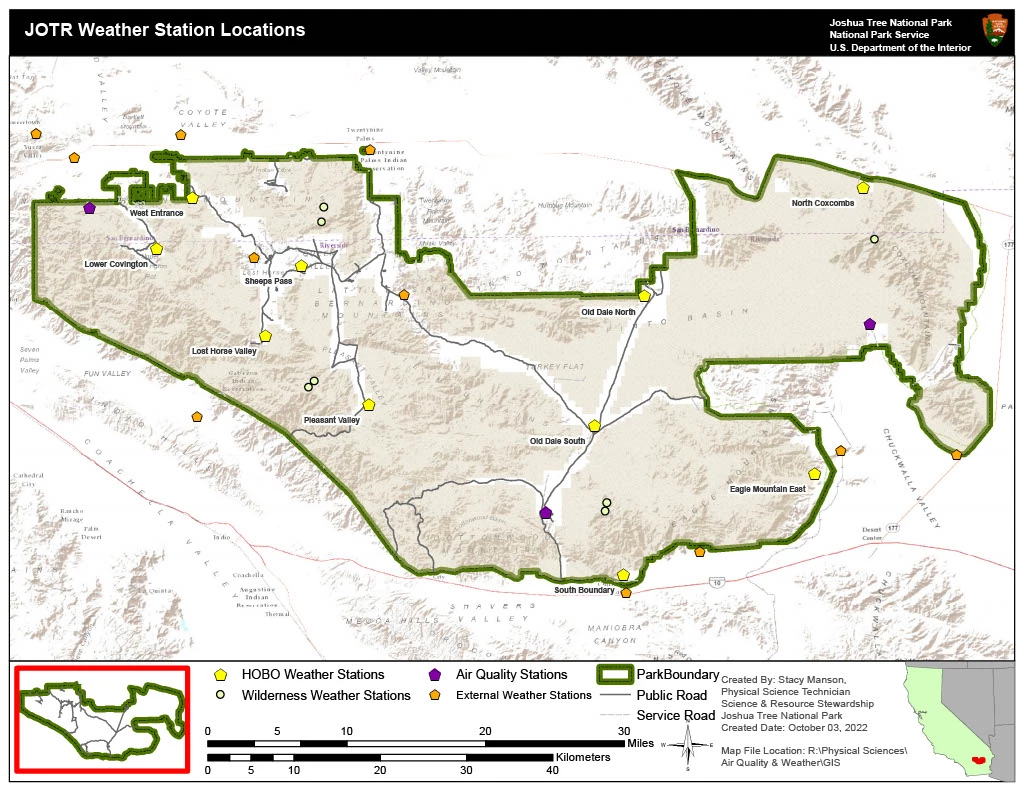Last updated: April 26, 2023
Article
Weather Monitoring and Climate Change Research

NPS Photos
Background
Joshua Tree National Park (JTNP) is collaborating with outside scientists to better understand the effects of climate change on plants and animals in the park. The Joshua Tree Climate Change Response Program (JTCCRP) includes researchers from UC Riverside Center for Conservation Biology, the California Desert Interagency Fire Program, USGS Western Ecological Research Center, Mojave Desert Native Plant Program, the Joshua Tree Genome Project, JTNP, and others. The collaboration has already produced several scientific papers describing the impacts of climate change on the JTNP's natural resources.
The program includes both weather monitoring and a long-term ecological study of the flora and fauna of JTNP and surrounding conservation lands. As a part of the study, 10 HOBO™ data-logging weather stations were installed throughout the park in 2014. The stations were sited so that each of the park’s three ecoregions would be adequately represented; they provide climatic data relevant to the 27 permanent biological monitoring sites used in the JTCCRP project. The table at right lists the 10 weather stations and their associated ecoregion.
Monitoring the Weather Stations
The 10 weather stations collect temperature, relative humidity, rainfall, and soil moisture at three depths (10, 20, and 30 cm) every 15 minutes. Although the stations operate automatically, data must be downloaded at least every 1.3 years. To ensure that the equipment is functioning properly and to minimize data loss, the stations are monitored biannually. For the first three years, each station had a site-specific maintenance/data offload schedule. In July 2017, the data from all stations were collected and a common maintenance schedule was put into place.
HOBO Weather Station Ecoregions
| Mojave Desert | Lost Horse Valley, Lower Covington, Sheep's Pass |
| Transition Zone | Old Dale North, Old Dale South, Pleasant Valley, West Entrance |
| Sonoran Desert | Eagle Mountain East, North Coxcombs, South Boundary |
Project Objectives
The primary goal of long-term monitoring of weather and soil moisture throughout the park is to determine impacts from climate change on JTNP natural resources, including the namesake Joshua tree (Yucca brevifolia). Secondary goals include coordinating with the park's Interpretation branch and the Office of Communications to help the public understand the impacts of climate change on the park.
Management Applications
The study of climate change and the ecosystems affected at Joshua Tree National Park will require a collaborative effort among scientists and a commitment to long-term monitoring. Plant and animal species are declining, the fire regime is changing, and excessive heat is impacting visitor safety. The goal of climate change management is to monitor trends and create plans to protect the resources at risk that can be saved, such as Joshua Tree refugia.

(NPS graphic / Stacy Manson)
